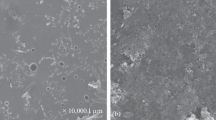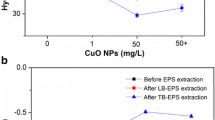Summary
The aim of this paper was to evaluate the possible enhancement of the biocidal efficacy of glutaraldehyde against Pseudomonas fluorescens biofilms by the application of an electric field. The behaviour of sessile cells and cells released by the biofilms was assed. Biofilms were formed on thin stainless steel coupons immersed in culture media inoculated with Pseudomonas fluorescens. Treatments using glutaraldehyde (TGA) and both glutaraldehyde and electric field application (TGAEF) were carried out with the samples with biofilms. TGA: samples with biofilms were immersed in glass cells containing a buffer solution with different glutaraldehyde concentrations in the 25–500 ppm range. TGAEF: samples with biofilms were immersed in an electrochemical cell containing glutaraldehyde solution where a direct electric current (4 × 10−4 A cm−2) was delivered to the chamber. The evolution of biofilms was observed through optical microscopy at real time. Results show that the electric field enhanced glutaraldehyde efficacy reducing the number of surviving cells in the range of one to four orders with respect to those with TGA treatment. The sensitivity of the cells to the treatments decreased in the following order: planktonic cells > cells released by the biofilm > sessile cells.
Similar content being viewed by others
References
V.S. Brözel G.M. Strydom T.E.E. Cloete (1995) ArticleTitleA method for the study of de novo protein synthesis in Pseudomonas aeruginosa after attachment Biofouling 8 195–210
W.L. Cochran G.A. McFeters P.S. Stewart (2000) ArticleTitleReduced susceptibility of thin Pseudomonas aeruginosa biofilms to hydrogen peroxide and monochloramine Journal of Applied Microbiology 88 22–30 Occurrence Handle1:CAS:528:DC%2BD3cXitVOitbo%3D Occurrence Handle10.1046/j.1365-2672.2000.00995.x
M.C. Cortizo M. Fernández Lorenzo de Mele (2000) ArticleTitlePreliminary characterization of thin biofilms by optical microscopy Biofouling 15 253–260
M.C. Cortizo M. Fernández Lorenzo de Mele (2003) ArticleTitleMicrostructural characteristics of thin biofilms through optical and scanning electron microscopy World Journal of Microbiology and Biotechnology 19 805–810 Occurrence Handle10.1023/A:1026069307547
J.W. Costerton Z. Lewandowski D.E. Caldwell D.R. Korber H.M. Lappin-Scott (1995) ArticleTitleMicrobial biofilms Annual Review of Microbiology 49 711–745 Occurrence Handle10.1146/annurev.mi.49.100195.003431 Occurrence Handle1:CAS:528:DyaK2MXovVWjtbg%3D
R.D. Donlan J.W. Costerton (2002) ArticleTitleBiofilms: Survival mechanisms of clinically relevant microorganisms Clinical Microbiology Reviews 15 167–193 Occurrence Handle10.1128/CMR.15.2.167-193.2002 Occurrence Handle1:CAS:528:DC%2BD38XjslGrurg%3D
R.G. Eagar J. Leder J.P. Stanley A.B. Theis (1988) ArticleTitleThe use of glutaraldehyde for microbiological control of waterflood systems Materials Performance 27 40–45 Occurrence Handle1:CAS:528:DyaL1cXlvFehu7Y%3D
Geesey, G.G. & Bryers, J.D. 2000 Biofouling of engineered materials and systems. In: Biofilms II: Process Analysis and Applications, pp. 237–279. In: Biofilms II. Process Analysis and Applications, ed., Bryers, J.D. New York-Chichester: Wiley-Liss, ISBN: 0471296562
Grobe, K.J. & Stewart, P.S. 2000 Characterisation of glutaraldehyde efficacy against bacterial biofilm. Corrosion/2000, Houston, TX: NACE International, Paper No.124.
K.J. Grobe J. Zahller P.S. Stewart (2002) ArticleTitleRole of dose concentration in biocide efficacy against Pseudomonas aeruginosa biofilms Journal of Industrial Microbiology 29 10–15 Occurrence Handle1:CAS:528:DC%2BD38XkslKnu7Y%3D
Lewandowski, Z. 1998 Structures and function of bacterial biofilms. Corrosion/98, Houston, TX: NACE International, Paper No. 296.
McFeters, G.A., Stewart, P.S., Huang, C.T., Wentland, E.J., Xu, K.D. & Yu, F.P. 1999 Physiological heterogeneity and biofilm control. In: Biofilms in the aquatic environment, eds. Keevil, C.W., Godfree, A., Holt, D. & Dow, C. pp. 51–60. Cambridge: Royal Society of Chemistry. ISBN 0854047581
A.R. Rice M.A. Hamilton A.K. Camper (2002) ArticleTitleMovement, replication and emigration rates of individual bacteria and biofilm Microbial Ecology 45 163–172
K. Sauer A.K. Camper (2001) ArticleTitleCharacterization of phenotypic changes in Pseudomonas putida in response to surface associated growth Journal of Bacteriology 183 6579–89 Occurrence Handle10.1128/JB.183.22.6579-6589.2001 Occurrence Handle1:CAS:528:DC%2BD3MXotFWmsrk%3D
K. Sauer A.K. Camper G.D. Ehrlich J.W. Costerton D.G. Davies (2002) ArticleTitlePseudomonas aeruginosa displays multiple phenotypes during development as a biofilm Journal of Bacteriology 184 1140–1154 Occurrence Handle10.1128/jb.184.4.1140-1154.2002 Occurrence Handle1:CAS:528:DC%2BD38XhtVeisrg%3D
S. Singleton R. Treloar P. Warren G.H. Watson R. Hodgson C. Allison (1997) ArticleTitleMethods for microscope characterization of oral biofilms: analysis of colonisation, microstructure and molecular transport phenomena Advances in Dental Research 11 133–149 Occurrence Handle1:STN:280:DyaK1c7osFWgtA%3D%3D Occurrence Handle10.1177/08959374970110010401
P.S. Stewart G.A. McFeters C. Huang (2000) Biofilm control by antimicrobial agents J.D. Bryers (Eds) Biofilms II Process Analysis and Applications. Wiley-Liss New York Chichester. 373–405
P.S. Stewart W. Wattanakaroon W. Goodrom S.M. Fortum B.R. McLeod (2000) ArticleTitleElectrolytic generation of oxygen partially explains electrical enhancement of tobramycin efficacy against Pseudomonas aeruginosa biofilms Antimicrobial Agents and Chemotherapy 44 292–296
P. Stoodley D. DeBeer H.M. Lappin-Scott (1997) ArticleTitleInfluence of electric fields and pH on biofilm structure as related to the bioelectric effect Antimicrobial Agents and Chemotherapy 41 1876–1879 Occurrence Handle1:CAS:528:DyaK2sXlvFOgtL0%3D
P. Stoodley I. Dodds J.D. Boyle H.M. Lappin-Scott (1999) ArticleTitleInfluence of hydrodynamic and nutrients on biofilm structure Journal of Applied Microbiology 85 19S–28S
P. Stoodley S. Wilson L. Hall-Stoodley J.D. Boyle H.M. Lappin-Sciott J.W. Costerton (2001) ArticleTitleGrowth and detachment of cell clusters from mature mixed species biofilms Applied and Environmental Microbiology 67 5608–5613 Occurrence Handle10.1128/AEM.67.12.5608-5613.2001 Occurrence Handle1:CAS:528:DC%2BD3MXovFehtrc%3D
P. Stoodley K. Sauer D.G. Davies J.W. Costerton (2002) ArticleTitleBiofilms as complex differentiated communities Annual Review of Microbiology 56 187–209 Occurrence Handle10.1146/annurev.micro.56.012302.160705 Occurrence Handle1:CAS:528:DC%2BD38Xos1Gis7o%3D
Videla, H.A., Guiamet, P.S., Gómez de Saravia, S.G., Sautú, A. & Fernández Lorenzo de Mele, M. 1991 Impact of glutaraldehyde on biofouling and microbiologically influenced corrosion of different stainless steels. Corrosion/91, Houston, TX: NACE, International, Paper No. 105
M.R. Viera P.S. Guiamet M. FernándezLorenzode Mele H.A. Videla (1999) ArticleTitleBiocidal action of ozone against planktonic and sessile Pseudomonas fluorescens Biofouling 142 131–141
M.R. Viera P.S. Guiamet M. FernándezLorenzode Mele H.A. Videla (1999) ArticleTitleUse of dissolved ozone for controlling planktonic and sessile bacteria in industrial cooling systems International Biodeterioration and Biodegradation 44 201–207 Occurrence Handle10.1016/S0964-8305(99)00078-5 Occurrence Handle1:CAS:528:DC%2BD3cXivVCksbY%3D
W. Wattanakaroon P.S. Stewart (2000) ArticleTitleElectrical enhancement of Streptococcus gordonii biofilm killing by gentamicin Archives of Oral Biology 45 167–171 Occurrence Handle10.1016/S0003-9969(99)00132-6 Occurrence Handle1:CAS:528:DC%2BD3cXosVWnsQ%3D%3D
K.D. Xu P.S. Stewart F. Xia C.-T. Huang G.A. McFeters (1998) ArticleTitleSpatial physiological heterogeneity in Pseudomonas aeruginosa biofilm is determined by oxygen availability Applied and Environmental Microbiology 64 4035–4039 Occurrence Handle1:CAS:528:DyaK1cXms1enu7s%3D
Author information
Authors and Affiliations
Corresponding author
Rights and permissions
About this article
Cite this article
Gómez de Saravia, S., de Lorenzo Mele, M. Enhancement of Glutaraldehyde Biocidal Efficacy by the Application of an Electric Field. Effect on Sessile Cells and on Cells Released by the Biofilm. World J Microbiol Biotechnol 21, 1077–1081 (2005). https://doi.org/10.1007/s11274-004-8288-1
Received:
Accepted:
Issue Date:
DOI: https://doi.org/10.1007/s11274-004-8288-1




